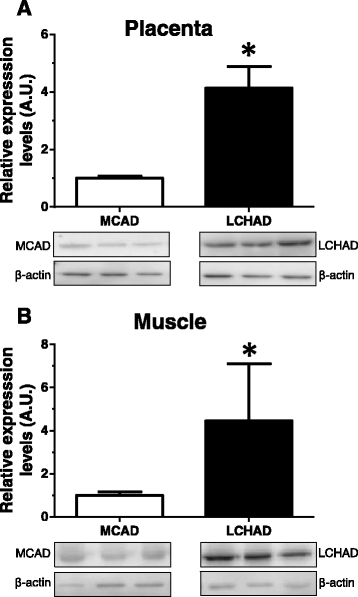Tissue specific expression of human fatty acid oxidation enzyme genes in late pregnancy
- PMID: 27871288
- PMCID: PMC5117526
- DOI: 10.1186/s12944-016-0373-6
Tissue specific expression of human fatty acid oxidation enzyme genes in late pregnancy
Abstract
Background: Abnormal fatty acid oxidation (FAO) is associated with maternal and fetal complications during pregnancy. The contribution of maternal and fetal tissues to FAO capacity during late pregnancy is important to understand the pathophysiology of pregnancy-associated complications. The aim of this study was to determine the expression levels of mitochondrial FAO enzymes in maternal and fetal tissues during late normal pregnancy.
Methods: We have measured by Real-time PCR the levels of long- and medium -chain acyl-CoA dehydrogenase (LCHAD and MCAD), two acyl-CoA dehydrogenases that catalyze the initial step in the mitochondrial FAO spiral.
Results: LCHAD and MCAD were expressed in maternal skeletal muscle, subcutaneous adipose tissue, placenta, and maternal and fetal blood cells. LCHAD gene expression was four- to 16-fold higher than MCAD gene expression in placenta, adipose tissue and skeletal muscle. In contrast, MCAD gene expression was ~5-fold higher in fetal blood than maternal blood (p = 0.02), whereas LCHAD gene expression was similar between fetal blood and maternal blood (p =0.91).
Conclusions: LCHAD and MCAD are differentially expressed in maternal and fetal tissues during normal late pregnancy, which may represent a metabolic adaptation in response to physiological maternal dyslipidemia during late pregnancy.
Keywords: Fatty acid metabolism; Long-chain acyl CoA dehydrogenase; Medium-chain acyl CoA dehydrogenase; Placenta.
Figures

Similar articles
-
Decreased Fatty Acid Oxidation Gene Expression in Pre-Eclampsia According to the Onset and Presence of Intrauterine Growth Restriction.Nutrients. 2023 Sep 6;15(18):3877. doi: 10.3390/nu15183877. Nutrients. 2023. PMID: 37764661 Free PMC article.
-
Long-chain fatty acid oxidation during early human development.Pediatr Res. 2005 Jun;57(6):755-9. doi: 10.1203/01.PDR.0000161413.42874.74. Epub 2005 Apr 21. Pediatr Res. 2005. PMID: 15845636
-
[Expression of long chain fatty acid oxidase in maternal and fetal tissues in preeclampsia-like mouse model in mid-gestation].Zhonghua Yi Xue Za Zhi. 2015 Jan 6;95(1):26-9. Zhonghua Yi Xue Za Zhi. 2015. PMID: 25876804 Chinese.
-
Mutation analysis in mitochondrial fatty acid oxidation defects: Exemplified by acyl-CoA dehydrogenase deficiencies, with special focus on genotype-phenotype relationship.Hum Mutat. 2001 Sep;18(3):169-89. doi: 10.1002/humu.1174. Hum Mutat. 2001. PMID: 11524729 Review.
-
Genetic and cellular modifiers of oxidative stress: what can we learn from fatty acid oxidation defects?Mol Genet Metab. 2013;110 Suppl:S31-9. doi: 10.1016/j.ymgme.2013.10.007. Epub 2013 Oct 12. Mol Genet Metab. 2013. PMID: 24206932 Review.
Cited by
-
Decreased Fatty Acid Oxidation Gene Expression in Pre-Eclampsia According to the Onset and Presence of Intrauterine Growth Restriction.Nutrients. 2023 Sep 6;15(18):3877. doi: 10.3390/nu15183877. Nutrients. 2023. PMID: 37764661 Free PMC article.
-
Neonatal carnitine concentrations in relation to gestational age and weight.JIMD Rep. 2020 Sep 8;56(1):95-104. doi: 10.1002/jmd2.12162. eCollection 2020 Nov. JIMD Rep. 2020. PMID: 33204600 Free PMC article.
-
Placental Compartmentalization of Lipid Metabolism: Implications for Singleton and Twin Pregnancies.Reprod Sci. 2021 Apr;28(4):1150-1160. doi: 10.1007/s43032-020-00385-2. Epub 2020 Nov 10. Reprod Sci. 2021. PMID: 33171514
References
-
- Sivan E, Homko CJ, Whittaker PG, Reece EA, Chen X, Boden G. Free fatty acids and insulin resistance during pregnancy. J Clin Endocrinol Metab. 1998;83:2338–42. - PubMed
-
- Assel B, Rossi K, Kalhan S. Glucose metabolism during fasting through human pregnancy: comparison of tracer method with respiratory calorimetry. Am J Physiol. 1993;265:E351–6. - PubMed
-
- Herrera E, Amusquivar E, Lopez-Soldado I, Ortega H. Maternal lipid metabolism and placental lipid transfer. Horm Res. 2006;65(Suppl 3):59–64. - PubMed

